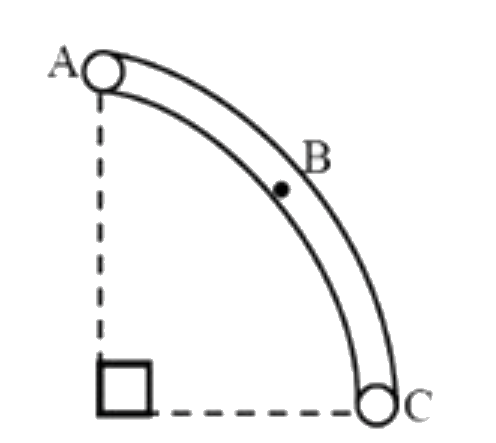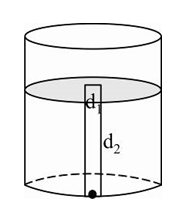The narrow tube AC forms a quarter circles in a vertical plane. A ball B has an area of cross-section slighly smaller than that of the tube and can move without friction through it. B is placed at A and displaced slightly. During the motion from A to C it will :

Always be in contact with the inner wall of the tube
Always be in contact with the outer wall of the tube
Initially be in contact with the inner wall and later with the outer wall
Initially be in contact with the outer wall and later with the inner wall.
The correct Answer is:C
Step by step video, text & image solution for The narrow tube AC forms a quarter circles in a vertical plane. A ball B has an area of cross-section slighly smaller than that of the tube and can move without friction through it. B is placed at A and displaced slightly. During the motion from A to C it will : by Physics experts to help you in doubts & scoring excellent marks in Class 11 exams.
Updated on:21/07/2023Topper's Solved these Questions
- WORK, ENERGY AND POWERBOOK - PHYSICS GALAXY - ASHISH ARORACHAPTER - WORK, ENERGY AND POWEREXERCISE - unsolvedMCQ
78 Videos
- WORK, ENERGY AND POWERBOOK - PHYSICS GALAXY - ASHISH ARORACHAPTER - WORK, ENERGY AND POWEREXERCISE - unsolved
1 Videos
- WORK, ENERGY AND POWERBOOK - PHYSICS GALAXY - ASHISH ARORACHAPTER - WORK, ENERGY AND POWEREXERCISE - Discussion Question
31 Videos
- RIGID BODIES AND ROTATIONAL MOTIONBOOK - PHYSICS GALAXY - ASHISH ARORACHAPTER - RIGID BODIES AND ROTATIONAL MOTIONEXERCISE - Unsolved Numerical
63 Videos
Similar Questions
One end of a U-tube containing mercury is connected to a suction pump and the other end to atmosphere. A small pressure difference is maintained between the two columns. Show that, when the suction pump is removed, the column of mercury in the U-tube executes simple harmonic motion.
View SolutionA ball of mass m is moved with speed v0 at the highest point in a closed circular tube of radius R kept in the vertical plane. The cross-section of the tube is such that the block just fits in it. The block makes several oscillations inside the tube and finally stops at the lowest point. Find the work done by the tube on the block during the process.
View Solution
Knowledge Check
The tube AC forms a quarter circule in a vertical plane. The ball B has an area of cross - section slightly smaller than that of the tube and can move without friction through it. B is placed at A and displaced slightly. It will
 Aalways be in contact with the inner wall of the tubeBalways be in contact with the outer wall of the tubeCinitially be in contact with the inner wall and later with the outer wallDinitially be in contact with the outer wall and later with the inner wall
Aalways be in contact with the inner wall of the tubeBalways be in contact with the outer wall of the tubeCinitially be in contact with the inner wall and later with the outer wallDinitially be in contact with the outer wall and later with the inner wallIn the track shown in figure -3.94 section AB is a quadant of a circle of 1 metre radius in vertical plane. A block is released at A and slides without friction until it reaches at B. After B it moves on a rough horizontal floor and comes to rest at D, 3 metres from B the coefficient of friction between floor and the body will be :
 A1/3B2/3C1/4D3/8
A1/3B2/3C1/4D3/8A wire, which passes through the hole in a small bead, is bent in the form of quarter of a circle. The wire is fixed vertically on ground as shown in the figure. The bead is released from near the top of the wire and it slides along the wire without friction. As the bead moves from A to B, the force it applies on the wire is
 Aalways radially outwardsBalways radially inwardsCraidally outwards initially and inwards laterDradially inwards initially and radially outwards later
Aalways radially outwardsBalways radially inwardsCraidally outwards initially and inwards laterDradially inwards initially and radially outwards later
An air chamber of volume v has a neck area of cross section a into which a ball of mass m just fits and can move up and down without any friction. Show that when the ball is pressed down a little and released for the time priod of oscillation, assuming pressure-volume variations of the air to be isothermal.
View SolutionA thin rod of length L and area of cross section S is pivoted at its lowest point P inside a stationary, homogeneous and non-viscous liquid. The rod is free to rotate in a vertical plane about a horizontal axis passing through P. The density d1of the rod is smaller than the density d2 of the liquid. The rod is displaced by a small angle theta from its equilibrium position and then released. Shown that the motion of the rod is simple harmonic and determine its angular frequency in terms of the given parameters ___________ .

View SolutionA thin rod of length L and area of cross section S is pivoted at its lowest point P inside a stationary, homogeneous and non-viscous liquid. The rod is free to rotate in a vertical plane about a horizontal axis passing through P. The density d1of the rod is smaller than the density d2 of the liquid. The rod is displaced by a small angle theta from its equilibrium position and then released. Shown that the motion of the rod is simple harmonic and determine its angular frequency in terms of the given parameters ___________ .

View SolutionA fixed non conducting smooth track is in the shape of a quarter circle of radius R in vertical plane. A small metal ball A is fixed at the bottom of the track. Another identical ball B, which is free to move, is placed in contact with ball A. A charge Q is given to ball A which gets equally shared by the two balls. Ball B gets repelled and ultimately comes to rest in its equilibrium position where its radius vector makes an angle θ(θ<90∘) with vertical. Mass of ball is m. Find charge Q that was given to the balls.

View SolutionIn the figure shown there is a smooth tube of radius 'R' fixed in the vertical plane A ball 'B' of mass 'm'is released from the top of the tube B slides down due to gravity and compresses the spring the end 'C' of the spring is fixed and the end A is free Initially the line OA makes an angle of 60∘ with OC and finally it makes an angle of 30∘ after compression find the spring constant of the spring

View Solution
